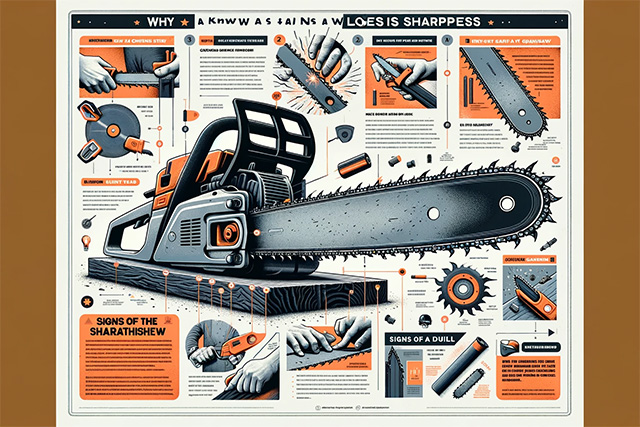In the hands of craftsmen and lumberjacks alike, the chainsaw stands as a symbol of power and precision, a testament to human ingenuity harnessed for the mastery of wood and rugged materials. Its origins, however, might surprise you. Conceived in 1830 with a vastly different purpose in mind – aiding in childbirth – this mechanical marvel has undergone a remarkable evolution, transforming into the formidable tool we recognize today.
For those who wield its might, ensuring peak performance isn’t merely a matter of preference; it’s a necessity. A dulled chainsaw not only hampers productivity but also jeopardizes safety. Understanding the factors that contribute to blade dullness is paramount. In this discourse, we’ll unravel the mysteries behind a chainsaw’s gradual loss of sharpness, empowering you to recognize the telltale signs of impending bluntness.
By unraveling the complexities of chainsaw maintenance and familiarizing yourself with the subtle indicators of a dulled blade, you hold the key to preserving the efficacy and durability of this indispensable tool. Embark with us on a journey into the realm of chainsaws, where we uncover the secrets to ensuring they remain sharp and ready for the toughest of tasks.
Understanding the Causes of Chainsaw Dullness
In the world of chainsaw expertise, it’s essential to grasp the various factors that contribute to the dulling of these powerful cutting tools. Chainsaws, when not properly maintained or used, can lose their sharpness, compromising their efficiency and performance. Let’s delve deeper into the primary culprits behind chainsaw dullness, exploring how to avoid them and keep your chainsaw in prime condition.
Ground Contact: A Silent Saboteur
One often underestimated threat to chainsaw sharpness is contact with the ground. Even a slight brush with the earth while the chainsaw is in operation can wreak havoc on its cutting capabilities. The ground, laden with abrasive sand, dust, and countless tiny rocks, poses a relentless assault on the chainsaw’s blade, slowly wearing it down. To safeguard your chainsaw, it’s crucial to avoid cutting wood resting directly on the ground. In cases involving large logs, exercise caution and reposition the wood as needed to prevent any inadvertent contact with the ground.
The Peril of Cutting Contaminated Trees
When it comes to felling or bucking trees, you’ll often encounter trees with bark encrusted with soil and dirt. Over time, this accumulation of debris can accelerate the dulling of your chainsaw. Tree barks, with their rough texture, have a remarkable ability to attract and retain substantial amounts of dirt and soil carried by the wind.
Fortunately, there’s a proactive measure to shield your chainsaw from the insidious effects of soil and dirt on tree barks. Before initiating the cutting process, consider removing the bark from the tree at the specific location you intend to cut. This doesn’t necessitate stripping the entire bark; instead, use an axe to remove the bark only at the designated cutting spot, ensuring a cleaner, more efficient cut.
Hidden Hazards: Foreign Objects in the Wood
While it may sound improbable, the wood you’re about to cut could conceal unexpected hazards like metal pieces, nails, or even embedded rocks. How do these foreign objects find their way into wood or trees? Nails, for instance, are often driven into trees or wood for various purposes, such as erecting signposts or constructing structures like birdhouses or treehouses. Regardless of their origin, these hidden obstacles have the potential to rapidly dull your chainsaw.
When confronted with such situations, consider using pliers to carefully extract the embedded nail or foreign object. However, exercising utmost caution is vital during this process. Alternatively, opt for an alternative cutting location if possible, or, if safety is a concern, discard the wood entirely to prevent damage to your chainsaw and ensure your safety.
Identifying a Dull Chainsaw
The significance of identifying a dull chainsaw cannot be overstated, as it can spell the difference between efficient cutting and frustrating, time-consuming labor. Regrettably, many chainsaw owners grapple with the challenge of pinpointing when their trusty tool has lost its edge. This article delves into the critical indicators that can help you unmistakably identify a dull chainsaw, providing you with the knowledge necessary to ensure optimal performance and longevity.
- Excessive Cutting Pressure: One of the clearest signals of a dull chainsaw is the need to exert an unusually high amount of force during cutting. When your chainsaw struggles to bite into wood, it’s a surefire indication that its cutting teeth have dulled over time.
- Fine Sawdust Over Coarse Strands: When you’re cutting against the grain, a well-sharpened chainsaw will effortlessly produce coarse wood strands. However, a dull chainsaw tends to generate fine sawdust instead of the expected rugged strands. This marked contrast in the texture of the wood remnants left behind is a telltale sign of a chainsaw in need of sharpening.
- Unexpected Smoke Emission: Another concerning symptom of a dull chainsaw is the emission of smoke, even when adequately lubricated. This smoke is a red flag, signaling the impaired condition of your chainsaw’s cutting teeth. Additionally, this issue often results in uneven cuts, further confirming the chainsaw’s dulled state.
In summary, the lifespan of a chainsaw’s sharpness depends on various factors, including meticulous operation and regular maintenance. Understanding the causes of rapid dulling and being proficient at identifying a dull chainsaw are pivotal steps in guaranteeing the peak performance and durability of this indispensable cutting instrument. By mastering these skills, you can elevate your chainsaw expertise to new heights and ensure that your chainsaw remains a reliable companion in your cutting endeavors.

